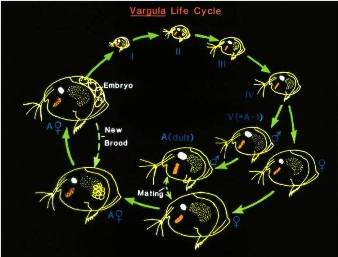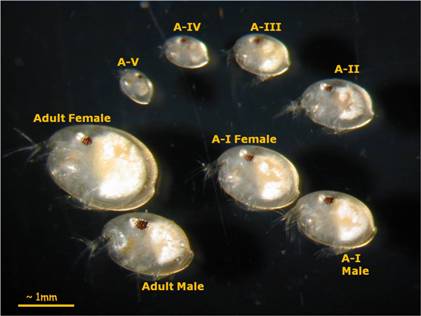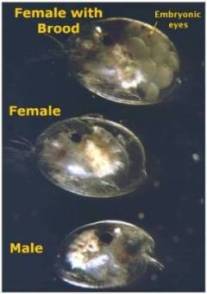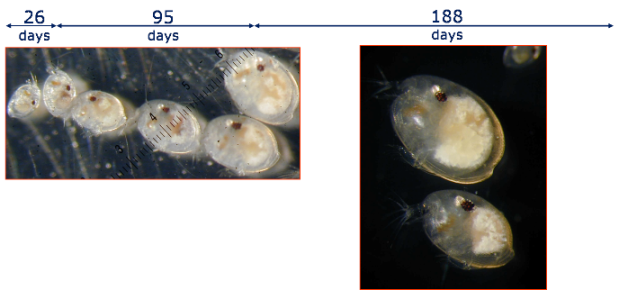From Egg to Embryo to Juvenile to Adult...
The life cycle of Photeros
annecohenae includes five juvenile
instars , separated by molts (that occur via the
process of ecdysis) as well as an
, separated by molts (that occur via the
process of ecdysis) as well as an
adult instar that is followed by a
final molt. Females become receptive after this terminal molt (Morin
1986).
Sexual dimorphism begins to become
apparent in the size and shape of the fifth instar and is even more
pronounced in the final adult stage. Each juvenile instar lasts
ten-27 days; therefore, it takes about three months for the juvenile
to fully develop (Gerrish 2009). Photeros annecohenae grows by
determinate growth, meaning it reaches a
conclusive size.

Eggs are located inside the body of the ostracod and,
when fertilized, are moved out into the brood
pouch in the carapace. Females have multiple
broods
 and give birth following a 26 +/-
1.6 day incubation period in which their embryos develop (Gerrish
2009). This is evidence that females put in more parental
investment than males (a factor in
sexual selection). Two to three days into development the
embryos appear cloudy. Faint, pigmented eye spots begin to develop
by day 15 which leads to fully-formed compound eyes by day 18
(Gerrish and Morin 2008). The
light organ is also apparent by this time.
On average, a female deposits 13 offspring per brood. After brood
deposition, a female normally takes 7.84 +/- 1.05 days to mate
again (Gerrish and Morin 2008).
and give birth following a 26 +/-
1.6 day incubation period in which their embryos develop (Gerrish
2009). This is evidence that females put in more parental
investment than males (a factor in
sexual selection). Two to three days into development the
embryos appear cloudy. Faint, pigmented eye spots begin to develop
by day 15 which leads to fully-formed compound eyes by day 18
(Gerrish and Morin 2008). The
light organ is also apparent by this time.
On average, a female deposits 13 offspring per brood. After brood
deposition, a female normally takes 7.84 +/- 1.05 days to mate
again (Gerrish and Morin 2008).
Females are capable of producing more than one
brood without remating. This indicates that they must
be able to store sperm, which further increases the sex ratio toward males (Gerrish Personal Communication).
remating. This indicates that they must
be able to store sperm, which further increases the sex ratio toward males (Gerrish Personal Communication).
Photeros annecohenae demonstrate a long
lifespan for crustaceans of their size (potentially nine and a half
months) (Cohen and Morin 1990). This may be due to the fact that
there is little known pressure
from predators to mature quickly because this species resides in the
benthos. Since the organism is more protected from predators by
residing at the bottom in the ocean in the grassbeds instead of in
the open sea, they do not need to adapt to protect themselves from
predators as rapidly. Photeros annecohenae develop slowly,
taking three months to become a mature adult. Speed of development
and size of final adult form are thought to be related to water
temperature, salinity and habitat (Cohen and Morin 1990).


In order to grow and develop into healthy adults, ostracods must be properly nourished. To learn more about this, investigate the Nutrition page!
